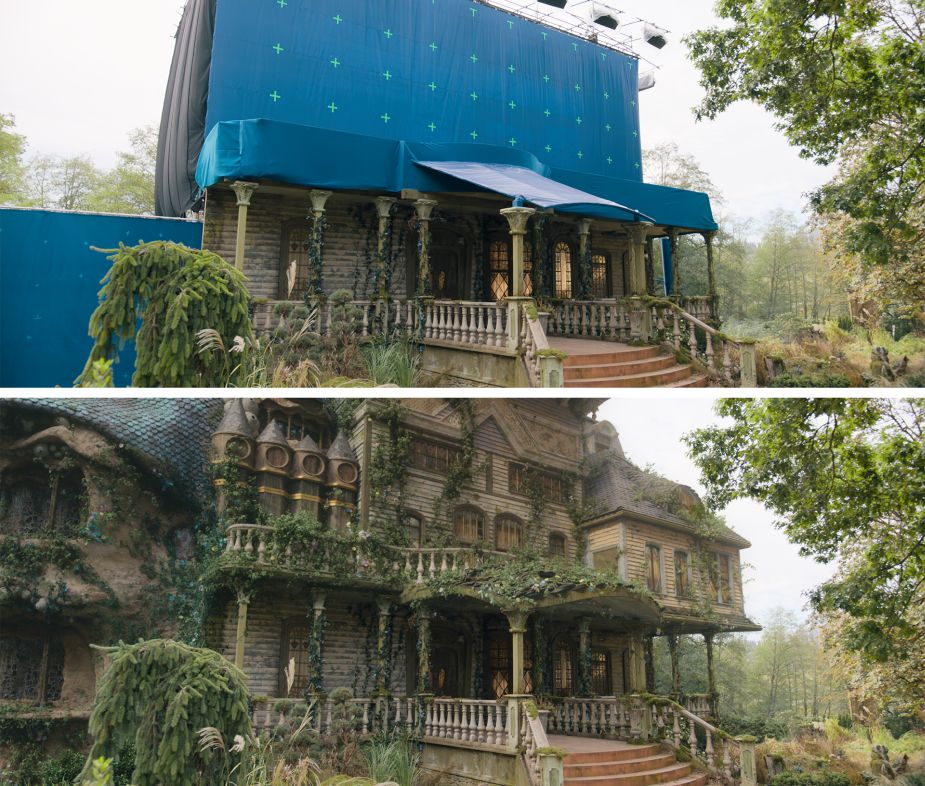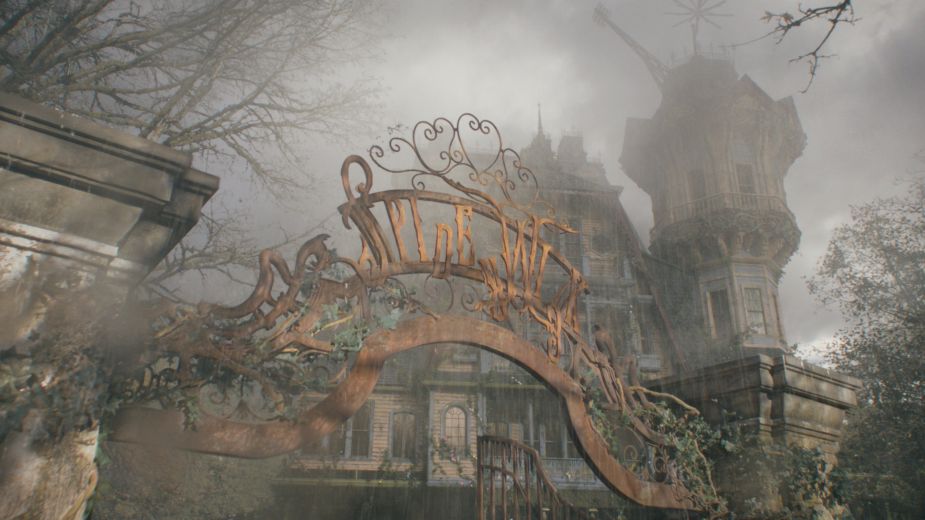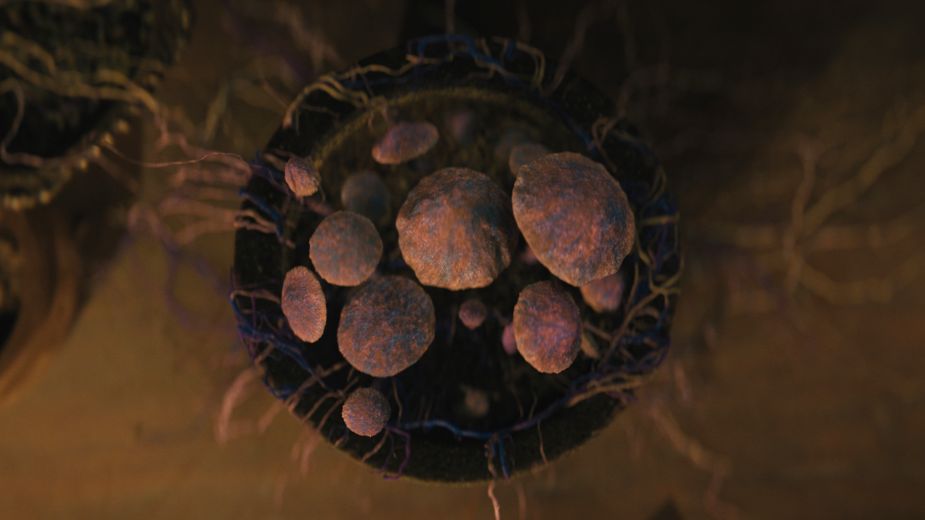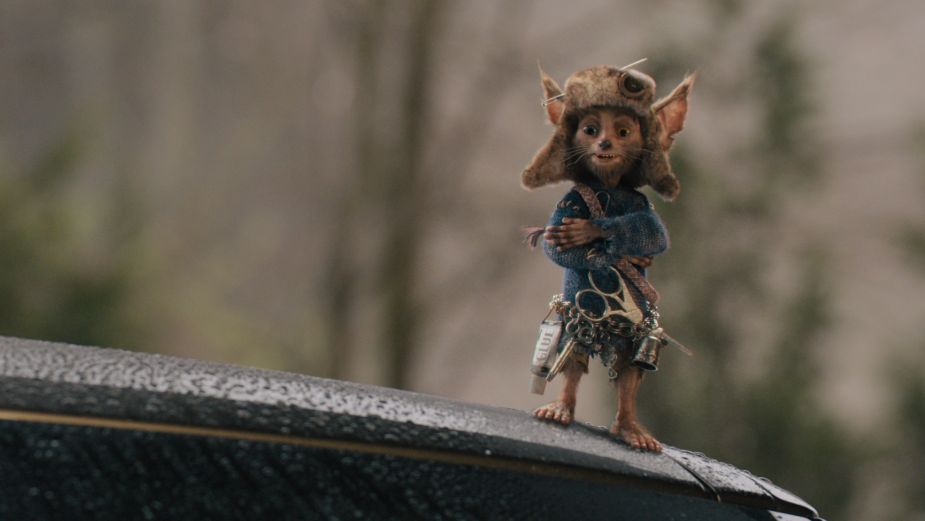
The Spiderwick Chronicles: How The Embassy Helped Spin a New Tale for a Beloved Story

Following the passing of their great-great Uncle, the Grace family decided to move back to their ancestral home. But, at the Spiderwick estate, all is not as it seems. Having unwittingly discovered a long-hidden field guide penned by his distant relative, young Jared Grace opens the door to a parallel secret world of faeries - and some other, darker forces that lurk within it.
So begins the Spiderwick Chronicles, which is now streaming on the Roku Channel. The fantasy-heavy show spins a spellbinding tale of magic, wonder, and surprise - and not without the help of stunning visual effects work. To that end, The Embassy were enlisted to bring life to the ambitiously-realised world of The Spiderwick Chronicles, with the studio’s work breaking down between characters and environments.
From a mythical boggart to faeries, and even including the Spiderwick Mansion itself, The Embassy team were kept busy with some considerable visual challenges. What’s more, the visuals lurched between the real world and the magical one (with some architecture designed by faeries themselves), ensuring that the team’s imaginations were put to good work in bringing the environments to beautiful life.
To find out more about the show and how its all-important visual effects were made, LBB caught up with VFX supervisor Michael Blackbourn, alongside compositing supervisor Sami Oms…
LBB> The character of Thimbletack must have presented plenty of challenges. What was your brief, or your aim, before digging into the work on him?
Michael> Thimbletack is a character of contradictions and layers. He’s old, having been hiding in the house for a hundred years. Yet as a boggart, he still has the spirit and energy of a cranky teenager. He’s a little mouse-like in his design, but also walks and talks like a small elf - the showrunner really didn’t want to play up any chimp or ape-like facial features or mouth positions.
His animation needed to be spry, while his look is that of a crusty dusty little critter that has spent his time in the dark places and between the walls of the mansion. But not too crusty - we tip-toed back and forth on the grey in his beard and wrinkles on his face until the creative team was satisfied.

LBB> How did you ensure that all of the tools on his little belt were moving in a believable manner? And was that the most challenging part of working on this character?
Michael> It was definitely one of the bigger challenges, but also one that - along with the excellent character animation - really helped give him a believable weight and presence.
When getting into this project we knew Thimbletack was going to be a little guy with some gear - but we were a little taken aback by just how much of it there was. There’s an array of dangling threads and stitches from his sweater, as well as accessories like his bracelet and sewing scissors. Each of these items had their own physical properties for us to consider.
It all had to move in a way that felt natural, whilst not attracting too much attention to itself. So, getting this right was truly a great achievement by our dynamics team. Every shot of Thimbletack has this fantastic layering on top of the animation work that brings a softness from the cloth, mixed with the swinging reaction of the hard metal charms on the bracelet. It was an ambitious and challenging design that really paid off in the final result.
Sami> On the comp side of things we had a few unique challenges. The disappearance effect for Thimbletack was all done in Nuke using point rendered particle effects. We created a setup for it that was finely adjusted for each shot depending on Thimbletack’s actions. Sometimes you’d see him disappear standing or sitting, sometimes running away, sometimes jumping, and all of those actions required a slightly different setup to match his motion.
Thanks to the amazing CG team we have, we had a great consistent base render to start compositing across all the varied environments. The renders from the lighting team were usually 90% there. We then created a starting setup for Thimbletack in Nuke to help artists keep his look consistent throughout the show. We did some spot improvements on Thimbletack in comp, like the “ape” mouth Mike mentioned and some balancing of his beard and eyes, but that was pretty much it.
LBB> Can you tell us how you work with footage from voice actors to get their movements and expressions aligned with the characters that audiences see on-screen?
Michael> The voice actor for Thimbletack was video recorded while delivering his performance. We received edits of the show with the dialogue cut in, and this reference take was superimposed in the corner. This allowed our animation team to have an initial visual guide on how the lines were spoken, and what kind of a face performance might perhaps go along with a particular reaction.
The videos are a good starting point. However as we move beyond the initial blocking phase it’s the animation team that brings Thimbletack to life, adding all the nuance and subtlety to the performance.
LBB> We’ve heard that some members of the Embassy team described Spiderwick as ‘an animator’s dream show’. What do you think they meant by that, and would you agree?
Michael> That’s great to hear. With regards to Thimbletack, I think the creativity involved is likely what sparked those feelings. He has great dialogue, has this cranky demeanour for most of the show and got to deliver much of the world building information to the viewer. For example, there are plenty of shots where he’s gesturing wildly describing the threats of dragons and making clear the stakes of how the townspeople will perish if they fail. He gets to ride around on people's shoulders, runs around diving out of holes in the walls, jumps onto or off of things all throughout the house, and has a brief dancing scene. All in all, there was a lot of fun energy for the animators to work with.

LBB> Besides the creature work, The Embassy also brought plenty of other elements in the show to life. With The Spiderwick Mansion, what was the most challenging part of putting that together?
Michael> The Spiderwick Mansion was also a challenge of layers. It was nestled into an overgrown estate, surrounded by trees and brambles having been abandoned for many years. Two versions of the first floor entryway were constructed as practical sets, one outside with a lot of real trees and foliage, one on a stage where we added the backdrop in post so the lighting and shooting times could be more controlled.
Having to tuck the extension of a mansion behind all those trees meant a lot of compositing considerations to layer things together in a convincing way. One of the more common but intense tasks in compositing is adding a dark object behind thin things that were shot over a bright sky. The luminosity of the sky scatters into all the edges of the foreground, and the integration work just takes a lot of time to get right.
After getting the 3D elements layered into the footage, we also had to dress the mansion in vines and flowers and sticks and leaves with the objective of giving it a grown-in feel. Along the development of the mansion we received notes that it was venturing into the haunted house domain a little too far. So we pulled the tone of the digital set back into a world of mystery, losing any sense of the sinister by dressing the vines with more flowers and leaning into a brighter patchwork colour scheme.
Sami> The main challenges in comp were that the mansion appeared in a few different lighting conditions, day time, rain, night time and heavy fog at night as well. All of those needed different setups.
An interesting challenge of a shot was when we see the mansion during a rainstorm, whilst the footage was shot in bright clear sun. That particular shot came out awesome in the end.

At the end of the show the house is surrounded by ambulance and police car lights, flashing red, blue and white all over the house enveloped by fog and behind tons of tree branches. Those were very tricky shots to get right, given all the manual work required to get all the light interaction working. The CG guys were really helpful and gave us plenty of animated light AOVs to match the vehicle’s positions.
LBB> We’ve seen shots of fantastical mushrooms sprouting up from the ground that your team was involved in, as well as flowers blooming to life. What was your process for visualising the nature-themed aspects of the show’s magic? Did you study the movement of plants/fungi in the real world, for example?
Michael> For all of the nature related magical creation we used the reference of time-lapse growth as a starting point. The way things twist and unfold in nature is really quite dramatic, it just creeps along so slowly how we experience it we never get to see it as things erupting into existence. This keeps our work feeling believable, even if what’s happening is something that’s only subconsciously familiar. This kind of VFX work always has a fun charm to it, and any time we get to bring the magic of the show to life we get excited.
Sami> The mushrooms were a unique challenge in comp. Some were rendered in CG but there were others that were also physical props lit internally by LEDs. In compositing we enhanced those, smoothing out any inconsistencies and making them look a bit more magical.

LBB> In a broad sense, did you look to any other fantasy universes for visual inspiration? If so, which?
Michael> Our first point of call was all the previous work done in the Spiderwick world. The books are illustrated by one of the authors and the work is just absolutely fantastic. We also reviewed what had been done in a previous film adaptation, to know how the work had been approached in the past when discussing how to bring this latest vision to life.
There were a few effects that had been done in various superhero films that had a similarity in what needed to happen in Spiderwick, that we referenced in conversations with the clients.
And one thing that we did reference was our own work from Warrior Nun. That show had many different types of magic, one major one being ‘phasing’ where a character could sort of ‘unknit’ themselves and travel through solid matter. Spiderwick needed an invisibility effect, so we used our work with Warrior Nun as a foundation on which to build that in a way that was totally bespoke for this universe.
LBB> When it comes to CG-heavy projects like this, why is attention to detail so important?
Michael> You have to pass a certain threshold for people to suspend disbelief when looking at something essentially unbelievable. Everyone knows that a little talking goblin mouse isn’t a real thing, but if you put enough care into the animation - the way it moves, and the way the light and environment interact with it - you can get the audience to start paying attention to the right things. You want audiences to think about things like: “I agree with what he’s saying, why is he such a cranky little guy, and where did he get that hat?” You start to invest in the performance and see him as just another actor on the show rather than as an effect.

LBB> Finally, do you have a personal favourite memory from your work across Spiderwick?
Michael> The pace of Spiderwick was fast, and there were a lot of things that had to go right with each animation revision as Thimbletack had so many layers of gear. The team dealt with it well and managed to keep to the schedule, but every now and again we would get a catastrophically funny result back from our dynamics crew. Thimbletack’s clothes would get snagged on the collision of something, and then everything would explode and shoot off into space. As a result, you’d be left staring at a naked little guy going through the motions with just part of his charm bracelet belt dragging on his ankle. Reviewing these was always a hit with the crew as it broke up the cycle of notes and revisions with some much-needed nonsense. Overall it was a pleasure to work on with a great team, and I hope we get to revisit Thimbletack and take him on new adventures in the future.
Sami> This show was extremely fun to work on, I'm a huge fan of look development in compositing. We got to come up with many different effects like Thimbletack’s disappearance, fairy glitter, vanishing and ghost effects, plus a flowery explosion. Although complex to achieve across many varied shots, it was a great exercise in creativity.
Another cool part of this show was that it was filmed on location in Vancouver. A couple of us went to the location after they finished shooting and gathered further detailed data, so that we could populate our composites with accurate elements.
Overall I couldn't be happier with the team we had for this show, incredible people helped make this possible. As challenging as the show was, it felt like a breeze because of the nature of the work.
Credits
VFX Supervisor
Michael Blackbourn
Compositing Supervisor
Nick Whiteley
Asset Supervisor
Paul Copeland
Executive Producer
Winston Helgason
Head of Studio
Steve Woo
Head of Production
Danielle Kinsey
Head of Studio - Spain
Gonzalo Moyano
VFX Associate Producer
Annie-Claude Lapierre
VFX Production Manager
Shruti Sidhan
VFX Coordinator
Evan Nip
Lead CG Artists
Austin Anderson
Gueschem Degni
Kim Savory
Lead Compositors
Riley Gray
Sami Oms
Roto and Paint Lead
Elizabeth Matthews
VFX Editor
Cassandra Yaseniuk
CG Artists
Alessandra Viecelli
Angela King
Ashley Graham
Cyril Martakov
Daniel Mandina
Darren Carter
Demara Davidson
Dmitri Bajenov
Francis Bezooyen
Gavin Seager
James Allan May
JD Buzz
Josh Lerio
Matt McKenna
Mauricio Maqueda Munguia
Michael Lowes
Michelle (EY) Kim
Minoo Haghdad
Nikita Lyu
Rafael Nuñez
Sanghoon Wes Lee
Solar Son
Teddy Vieux
Waqar Alam
Compositors
Agustin Cavalieri
Alexis Menacho
Allan Morel
Brandon Hines
Charlotte Brancucci
David Koss
Fani Vassiadi
German Benaiges
Harshal Soitkar
Kyle Lie
Marc-Andre Gray
Piyush Jinjala
Rolph Thomas
Venkatesh Rajagopal
IT Managers
Bradley Stanish
Prashob Nair
Pipeline Supervisor
Dushyant Kashyap
Additional VFX
Haymaker













